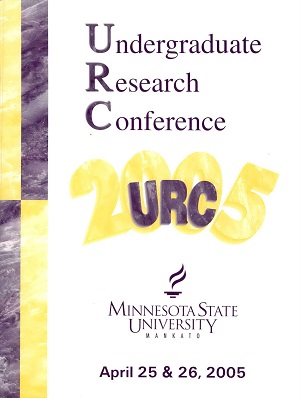Agricultural Contribution to Water Quality in Southern Minnesota
Location
CSU 202
Start Date
25-4-2005 1:15 PM
End Date
25-4-2005 3:00 PM
Student's Major
Geography
Student's College
Social and Behavioral Sciences
Mentor's Name
Changjoo Kim
Mentor's Department
Geography
Mentor's College
Social and Behavioral Sciences
Description
Approximately seventeen of the United States' twenty-one water resource regions currently suffer from inadequate surface and groundwater supplies (USGS). There are several factors contributing to this phenomenon; including flooding, soil erosion, sediment accumulation and surface and groundwater pollution. Poorly managed farms in the upper Midwest are a source of increasing pollution to various types of water resources throughout the region. The focus of this research is to provide land users, managers, and planners information relating to cultivated lands, in order to make more educated and timely decisions. Geographic Information Systems (GIS) are employed as the primary tool for collecting, analyzing, manipulating, visualizing and finally, monitoring the effects of commercial scale agricultural operations on soil as well as surface and ground water in southern Minnesota. This research considers the natural factors influencing the quality of streams and rivers in Blue Earth County, Minnesota, as well as the effects of agricultural components-varying tillage practices and soil composition. Finally, complimentary analytical methods-aerial photography and remote sensing-are coupled with the GIS to monitor and track changes in water quality.
Agricultural Contribution to Water Quality in Southern Minnesota
CSU 202
Approximately seventeen of the United States' twenty-one water resource regions currently suffer from inadequate surface and groundwater supplies (USGS). There are several factors contributing to this phenomenon; including flooding, soil erosion, sediment accumulation and surface and groundwater pollution. Poorly managed farms in the upper Midwest are a source of increasing pollution to various types of water resources throughout the region. The focus of this research is to provide land users, managers, and planners information relating to cultivated lands, in order to make more educated and timely decisions. Geographic Information Systems (GIS) are employed as the primary tool for collecting, analyzing, manipulating, visualizing and finally, monitoring the effects of commercial scale agricultural operations on soil as well as surface and ground water in southern Minnesota. This research considers the natural factors influencing the quality of streams and rivers in Blue Earth County, Minnesota, as well as the effects of agricultural components-varying tillage practices and soil composition. Finally, complimentary analytical methods-aerial photography and remote sensing-are coupled with the GIS to monitor and track changes in water quality.
Recommended Citation
Pelz, Zachary. "Agricultural Contribution to Water Quality in Southern Minnesota." Undergraduate Research Symposium, Mankato, MN, April 25, 2005.
https://cornerstone.lib.mnsu.edu/urs/2005/oral-session-G/3



